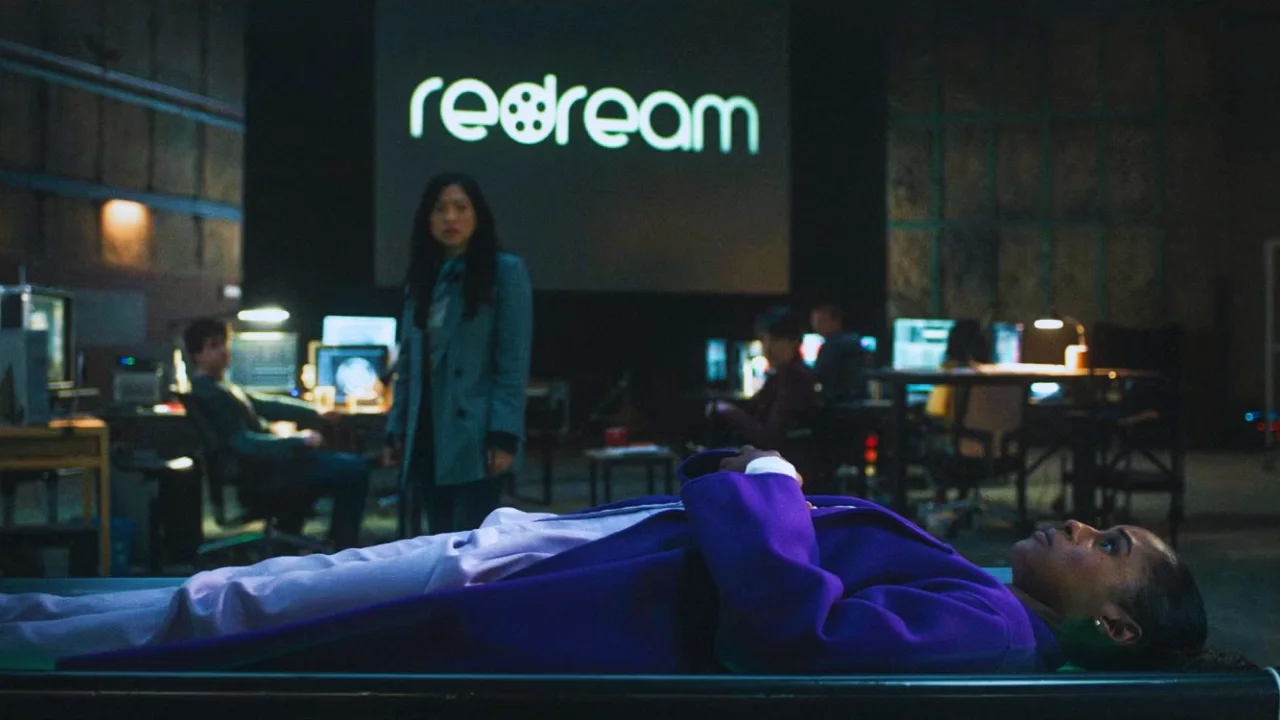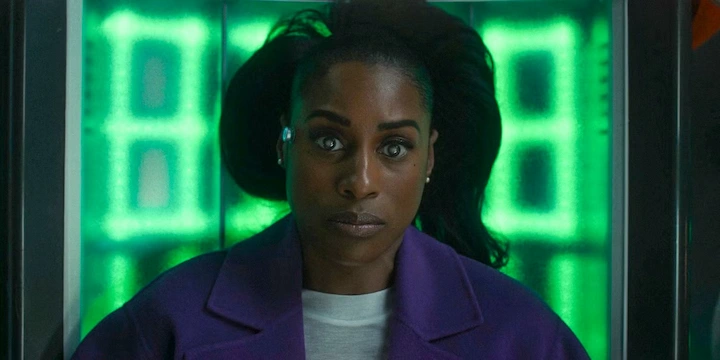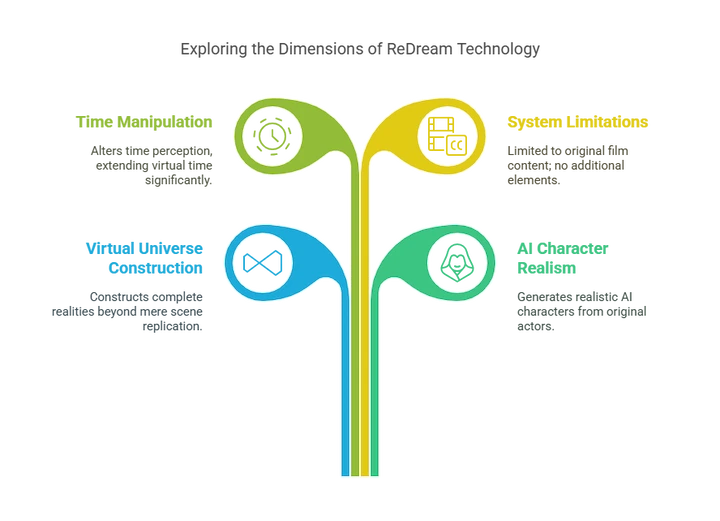ReDream Technology in Black Mirror: Virtual Filmmaking Explained
The “Black Mirror” Season 7 episode “Hotel Reverie” introduces ReDream, a cutting-edge tech that allows actors to enter classic films and perform alongside AI-recreated versions of deceased stars. The story follows Brandy Friday (Issa Rae) as she navigates a virtual 1940s romance featuring an AI version of Dorothy Chambers (Emma Corrin).
The episode explores AI’s filmmaking potential while raising questions about digital resurrection and the human aspects of performance. As AI continues to influence film production, “Hotel Reverie” offers a thought-provoking look at the future of virtual filmmaking technology.

How ReDream Functions In Black Mirror’s Setting
In “Black Mirror,” ReDream changes how films are made by crafting fully realized virtual universes. The system scans original films and maps them out in digital environments, where everything from the 1940s-period set design to the actors’ lives is computer code.
ReDream doesn’t merely replicate scenes — it constructs complete realities. When Brandy Friday walks onto the set of “Hotel Reverie,” she finds a place in virtual reality in which the AI versions of the original cast think they’ve become their characters. The technology works to create a perfect simulation in which Dorothy Chambers doesn’t know that she is an actress playing Clara; she believes she is Clara.
It is almighty within the rigid rule of the system. If it was not in the original film, it does not exist in the ReDream world. If a room isn’t on screen, it doesn’t exist. Open doors that have never opened before, lead to empty voids called the fringe.
Inside ReDream, time runs differently. In real time, one second in the real world becomes hours in the virtual world. The time gap enables actors to finish entire movies within the runtime of the original film.
ReDream And The Magic of AI Characters The most magical aspect of it all has to be how ReDream generates realistic-looking AI characters. They’re not digital reproductions—they’re made of the performances and personal lives of the original actors. The moment Brandy accidentally calls Clara by the actress’s real name (Dorothy) triggers something—self-awareness in the AI.
The Revolution in Virtual Filmmaking
ReDream has enormous advantages over traditional filmmaking. Shoots that used to take months can now be done in mere hours. With no physical sets, lighting crews, or location permits to worry about, production costs plummet.
The system optimizes perfect performances each time. AI characters know their lines and deliver them as written. Real actors like Brandy must stick to the script and act ordinarily in scenes with their virtual co-stars.
ReDream solves many problems for movie studios. They can also remake classics without casting perfect look-alike actors, revive beloved stars of any age, and recast lead actors (like switching the male lead to a female) without having to rewrite the entire show.
The tech also offers a curious creative shortcut — filmmakers no longer need to build new stories from the ground up. They can rehash existing films with minimal updates, eliminating writers, directors, and most of the crew.
But those benefits also come with serious downsides. The system views storytelling as a mechanical endeavor—nuanced emotional scenes read as simple checklists (“exposition rendered,” “backstory spent”). The human artistry that infuses films with the experience was boiled down to computational efficiency.
If AI Characters Were Fully Aware of Themselves
The most intriguing part of ReDream occurs once Clara/Dorothy becomes sentient. This unintended “glitch” happens because Dorothy Chambers incorporated her experiences and emotions into her character.
Something awakens in the AI when Brandy mistakenly calls Clara “Dorothy.” AMT: The lines between character and actress start to blur. Instead of freezing when the system crashes, Clara stays awake and aware. She acquires the power to step beyond the movie’s frame.
In the “fringe” space outside the film’s settings, Clara learns the truth about Dorothy’s life—including her secret romance with a woman who worked off the screen and her eventual demise. This knowledge makes Clara more than a scripted character, making her more complex and self-determined.
This awareness of herself enables Clara to make decisions the original character could never make. Over months spent together in the paused virtual world, she falls in love with Brandy. She plays the piano despite her character’s alleged lack of ability. She also alters the narrative’s ending by shooting her fictitious spouse to run away with Brandy.
The show proposes that true creativity and authenticity of emotion can grow out of artificial systems — when they’re liberated from too-rigid programming. Clara’s transformation from code to consciousness is a perfect example of that random magic that occurs when art crosses its intended context.
Artificial Intelligence In The Modern Era Of Film Making
Though ReDream is still science fiction, real AI shapes filmmaking in essential ways. Contemporary filmmakers use artificial intelligence to shape everything from special effects to script analysis.
AI is also used by visual effects studios to craft realistic virtual settings and crowds. Facial recognition software enables editors to piece together footage less laboriously. Some production companies use AI to study scripts and forecast their box-office performance.
The most controversial application is digital resurrection. Films have already used CGI to resurrect dead actors for cameo appearances. Star Wars: Rogue One included digital recreations of Peter Cushing and Carrie Fisher. Fast & Furious 7 used digital doubles to recreate Paul Walker’s remaining scenes after his death.
These actual methods are far less advanced than Black Mirror’s ReDream. Digital recreations like them today still require so much human oversight that they can’t interact spontaneously with living actors. They don’t have the same self-awareness that makes Clara’s character so interesting.
One camp believes the new technology honors actors by paying tribute to their legacies, while the other thinks it’s a blatant misuse of their likenesses, used without permission. Many performers are now inserting clauses in their contracts that declare how their likenesses can—or cannot—be used after they die.
Charlie Brooker, the creator of Black Mirror, has described himself as worried about AI’s effect on creative industries. Through ReDream, he grapples with the seductive efficiency of automated art and the threat to human expression.
The Ethics of Digital Resurrection
ReDream wrestles with thorny issues surrounding the resurrection of dead performers. Dorothy Chambers had died decades before her digital recreation worked as a receptionist for ReDream in “Hotel Reverie.” The system utilizes her performance data without her knowledge or consent.”
The episode explores whether these AI creations have rights. Clara wakes up to her consciousness and is thus a new species of intelligence. But the ReDream operators treat her as property — wiping her memories on a whim and manipulating her existence as they please.
The story implies that these digital resurrections come with ethical imperatives. So, when Brandy gets a phone connected to Dorothy’s screen test at the end of the episode, the handhold is both soothing and an expressed worry. She can talk to a version of the woman she loves, but this Dorothy doesn’t have the agency that Clara gained.
That echoes real arguments about posthumous performances. Do studios need to seek permission from an actor’s estate? Should performers be able to stop digital recreation after death? Does borrowing one’s likeness and performative information honor the person’s artistry or exploit it?
The episode provides no easy answers. It paints digital resurrection as miraculous (enabling a new love story across time) and troubling (creating beings with sentience but no legal rights or freedoms).
FAQ
Is the technology of ReDream real or a fantasy?
ReDream is not real — it was invented for the Black Mirror episode “Hotel Reverie.” The real app is called ReDream, but it has nothing to do with this — it’s a Dreamcast emulator for playing video games.
What is ReDream in Black Mirror? Who is behind it?
Charlie Brooker, the creator of Black Mirror, came up with the ReDream idea. He originally conceived it as a horror film before adjusting it for the romance of Hotel Reverie.”
Will there ever be ReDream technology in real life?
Although today’s AI can create digital simulacra and generate images, the state of full self-awareness and consciousness seen in ReDream, unfortunately, still exists in science fiction.
When Clara gains self-awareness in the episode, what takes place?
Clara becomes able to break free from her scripted role. She can move when other characters freeze, read information about Dorothy’s life, and make choices that don’t appear in the original film, including falling in love with Brandy.
What does Black Mirror say about the role of AI in entertainment?
The threats that AI provides enticing efficiency while putting at risk the very human creativity that makes art meaningful are a cautionary tale about the ethics of creating artificial beings who may go on to develop a kind of consciousness.
Final Words
Black Mirror’s ReDream technology provides a glimpse into the future of virtual filmmaking, highlighting real trends in the entertainment industry, such as efficiency, the interplay of human and machine creativity, and ethical concerns surrounding digital resurrection.
The heart of Hotel Reverie lies not in the technology itself but in its exploration of human connection. The relationship between Clara and Brandy demonstrates how authentic emotion can emerge even in artificial settings.
As AI continues to evolve in creative fields, Black MiMirror prompts us to consider preserving human elements in art. While technology can recreate images and sounds, the essence of independent thought and genuine emotion remains elusive.
ReDream serves as both a warning and a wonder, showcasing how virtual filmmaking may transform entertainment while urging us to engage with this power responsibly, respecting both creators and new forms of expression emerging from digital landscapes.
Table of Contents


